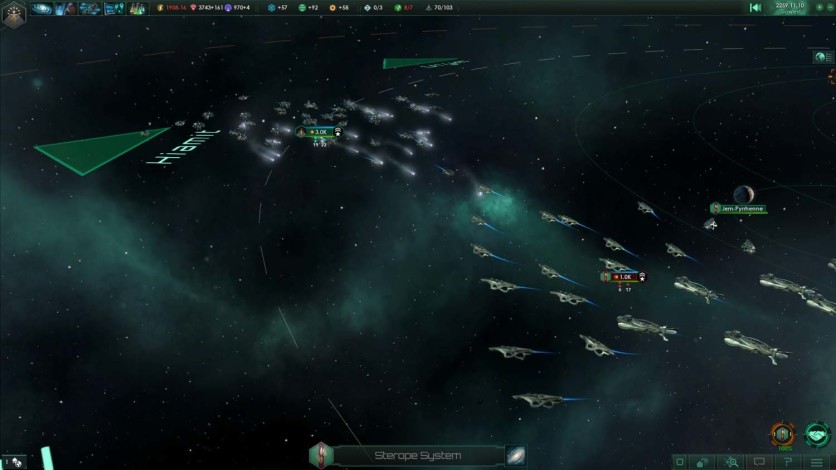In this guide, I’ll explain everything you need to know about weapon types, shields, armor, accuracy, and other aspects of fleet combat. You’ll learn how to design ships so that you take the fewest losses, while dealing the most damage.
Introduction
When you’re designing your ships there’s a lot of information you have to keep track of. Hull? Shields? Cooldown? Power? Damage? Tracking? Range? What does all this mean? What is important and what is not?
You might think it can’t matter that much. After all, there’s this nifty auto-complete button for your ship design, how bad could that be? And sure, it’ll do, most of the time. But if you want to truly be the best at warfare, to beat enemies many times bigger than you while using a fleet that’s as manageable and economical as possible, you need to understand how combat works.
I’m going to tell you all about it. First, I’ll explain what the different stats mean through an example. We’ll fire a weapon at an enemy ship and go through each step to see what happens during combat.
Then, we’ll take a more in depth look at how different modules and weapon types work. What’s the difference between shields and armor? When do you use lasers and when do you use missiles? What are all these obscure rare weapon types?
Finally, we’ll look at a practical example of an enemy fleet composition, and we see how we can build our own fleet to counter it as best we can.
Stats, what do they mean?!
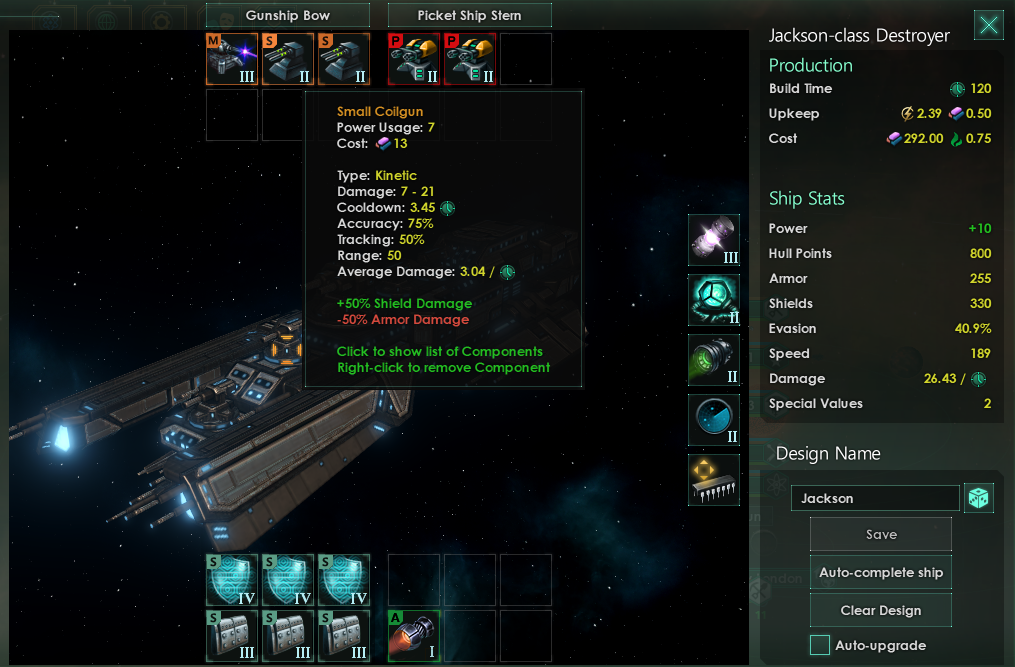
In our example, a ship made of this design, a Jackson-class destroyer, will be our proud fighter, engaging this enemy corvette:
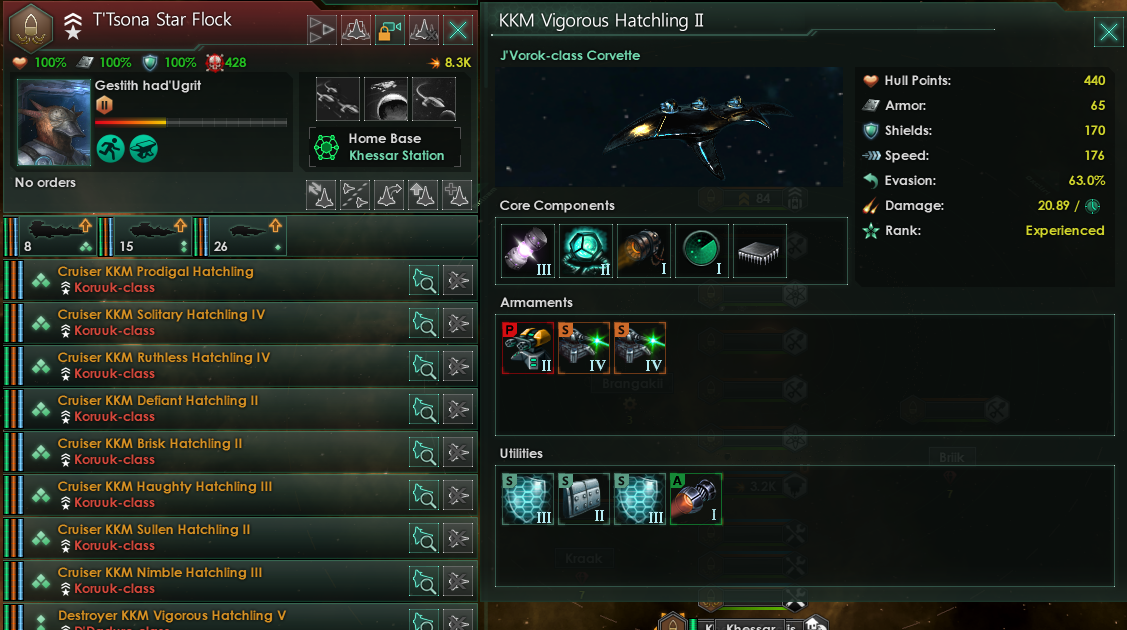 :
:
There are a lot of stats to look at here, both ship-wide like Speed, Hull, and Evasion, and stats specific to the weapon like Range and Damage. We will now see how each stat comes into play during combat.
Before fighting can begin, our ships first need to find the enemy and get close enough for combat. Speed (also known as Sublight Speed) is the speed your ship will have when travelling through a system. Smaller ships tend to be faster. Having faster ships is always good, as it allows your ships to get in range quicker. Our destroyer has a speed of 189 while the enemy corvette has a speed of 176. So our ship is slightly faster than the enemy’s, which is good if the enemy is trying to flee from us, since we’ll eventually overtake them.
That brings us to Range. Each weapon has a range value. Our highlighted weapon, the Small Coilgun, has a range of 50. This means that unless there’s a target within distance 50 of the destroyer, this gun isn’t shooting at anything. This is why speed is useful, especially for weapons with low range. It allows you to get close and fire those guns as fast as possible.
Now we’ve engaged the enemy corvette and our weapon is in range to fire. Now we’re going to see if we actually hit. There are three stats that together form the total Chance To Hit .
First and foremost is the enemy’s Evasion. This is a measure of how maneuverable the ship is and how well it can react to enemy fire. Smaller ships with good thrusters tend to have good evasion. After all, it’s much easier to turn a small fighter than a three-mile long battleship. The enemy corvette has an evasion of 63%.
The attacker’s counter to evasion is Tracking. Tracking means how good a gun is at predicting where the enemy will move next and adapt accordingly. Our coilgun has a tracking of 50%, and our lvl 2 sensors add another 5%, giving our shot a tracking value of 55%. The tracking value is subtracted from the enemy’s evasion to form Effective Evasion. In our example, the enemy has an effective evasion of 63 – 55 = 8%.
Finally we have Accuracy. Accuracy describes how good the weapon is at firing at an enemy ship in general. The coilgun has an accuracy of 75%. Now Effective Evasion is subtracted from the accuracy to get the Chance to Hit. So here we get a CtH of 75 – 8 = 67%. This means that there’s a 67% chance of the shot connecting and doing damage.
You might be wondering what the real difference is between accuracy and tracking. After all, they both increase your eventual chance to hit. Weapons tend to have either fairly good accuracy and low tracking, or medium accuracy and a lot of tracking. The difference in their performance depends on how good the enemy is at evading. If your weapon has accuracy 70 but 0 tracking, and the enemy has 60% evasion (common for corvettes), that means only 10% of your shots are going to land. But if your enemy has 5% evasion (common for battleships) you hit 65% of the time.
If, however, you use a weapon with 40% accuracy and 70% tracking, the corvette will have 0% effective evasion (the tracking completely negates the evasion, and even has a bit of overkill), and you’ll hit 40% of the time. However, against the battleship you will also hit only 40% of the time. So it very much depends on the enemy ship types how much tracking and accuracy you want.
So we hit our enemy ship! It’ll go down now, right? If only it was that simple. Ships have 3 main stats related to their health.
The first and most important stat any ship has is hull. Hull is, simply put, the amount of hitpoints a ship has. A ship dies when its hull level reaches 0. The corvette has 440 hull.
The next stats are armor and shields. These are additional health bars. When you design a ship from scratch, it starts with 0 shields and armor, but by adding defensive components you increase this value. The way they work is that any damage you take is subtracted from shields first, and only when all shields are gone, armor will be damaged. Only when armor is gone, hull is damaged. If shields are damaged, they will automatically recharge once out of combat. Hull and armor has to be repaired at a starport. The corvette starts with 170 shields and 65 armor.
Weapons have different advantages against the different health types. Our coilgun, for example, does 50% extra damage against shields but 50% less damage against armor. So let’s say we get lucky and we roll a 18 on the 7-21 damage roll. If the enemy corvette has 12 shields left at that point, we use 8 of our damage to remove the last of those (with the extra 50% damage) and then the remaining 10 damage is inflicted on armor, which is lowered by 5 (because of the 50% damage reduction to armor).
We’ll be looking at weapon types in greater detail in the next section, where we see all kinds of different weapons and the way they counter or avoid these defense strategies.
The last value we need to look at is Cooldown Time. After a weapon fires, it needs some time to reload and prepare another shot. Our coilgun takes 3.45 days to fire again. The game helpfully provides an Average Damage per day value, based on cooldown time, damage, and accuracy. Obviously in practice this won’t always be the damage you inflict, since that also depends on evasion, tracking, and damage increase/reduction, but it’s a good baseline to quickly compare different weapons.
Countless ways to kill people, or: A guide to weaponry
Sections and Weapons Sizes
The first thing you have to do when you start a new ship design is pick Sections for your ships. You get several choices, each with different weapon types and sizes.
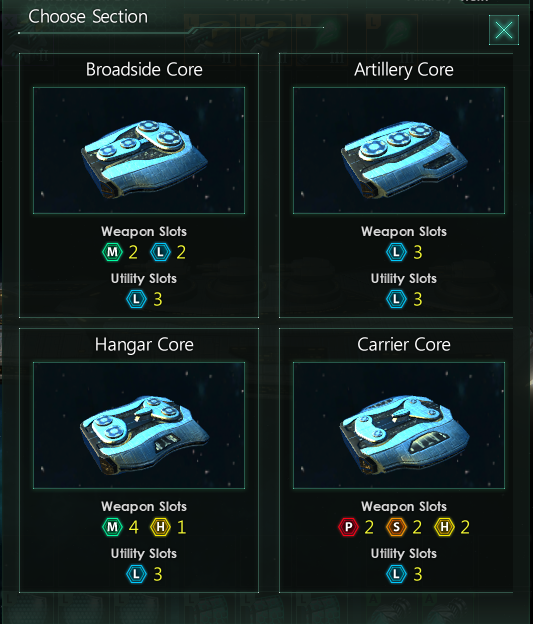
When you design a ship, you’ll notice that your weapons and defense components (the little squares you put your lasers and shields in) come in three different sizes: Small, medium, and large. In general, Medium is twice as ‘good’ as small, and large is twice as ‘good’ as medium. What ‘good’ means depends on the type of component. A medium shield provides twice as much shield power than a small shield. A large laser does about twice as much damage as a medium laser. There are some exceptions to this, but that is the basic gist. Notice how in the picture (of battleship sections) you get the choice between three L weapons or 2 M weapons and 2 L weapons. The 2 M weapons mostly balance out the third L.
However, sizes tend to have tradeoffs. Larger weapons tend to have much higher damage and range, but lower tracking. In general Large weapons are still stronger than an equivalent Small weapon, but against a horde of corvettes with high evasion you might want to use different weapon sizes than when fighting a citadel with 0 evasion. If you have enough large long-range weapons you also might be able to damage or destroy corvettes before they get into their range to attack you, despite their high evasion.
In addition to standard weapons with sizes, some sections also offer some different weapon types: Explosives (G), Point-Defense (P), and Hangars (H). We will explain those in a bit.
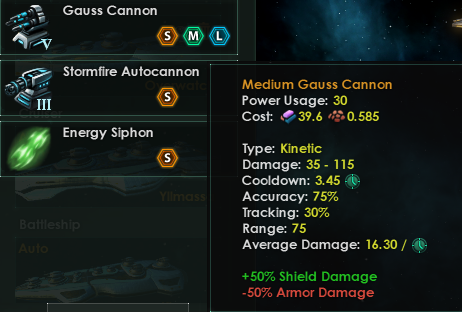
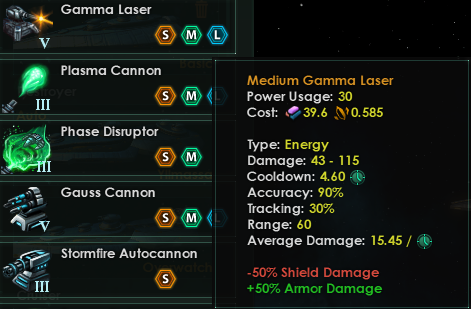
The main weapon slots, the ones that can be S, M, or L, are pretty much always filled by either a kinetic weapon or an energy weapon. Kinetic weapons fire projectiles accelerated to incredible speed at enemy ships, like the guns in Mass Effect. Kinetic weapons are good against shields, but weak against armor.
Energy weapons are the exact opposite. They use direct energy: plasma, lasers, electricity, to damage the enemy ship. Energy weapons are good against armor but weak against shields.
In general energy and kinetic weaponry is the backbone of your loadout: The majority of your weapon slots will be these, and the big choices here are about balancing their ratio. If the enemy has a lot of shields, go for kinetic. A lot of armor, go energy. To take on a variety of enemies, you’ll want a mix of them.
Note that range comes into play here as well. Kinetic weapons tend to have longer range than energy, and shields will be attacked first. So when designing your fleet you might want to make your long-range artillery kinetic, since they’ll fire first and whittle down shields, and that’s when short-range energy weapons have come in close to take down armor.
Weapons, Part 2: Point-Defense, Explosives, and Strike Craft
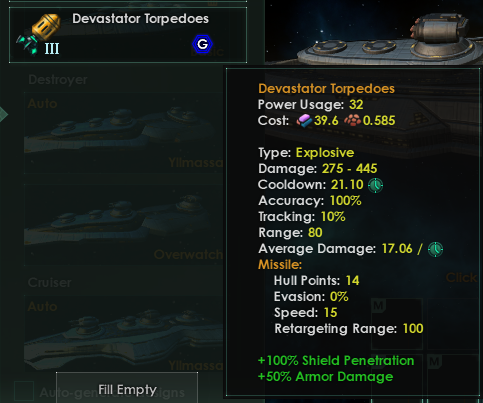
Explosive weapons use self-propelled devices, like torpedoes and missiles, to deliver huge bombs to the enemy. If you look simply at the Average Damage per Day value and compare it to kinetic and energy weapons, you’ll notice explosives tend to have way higher damage than regular weapons of the same tech tier. In addition to that, explosives tend to have Penetration. Penetration means it completely avoids the healthbar and will directly damage the underlying bar. For instance, this explosive has 100% shield penetration, meaning it will do its full damage to armor and hull, so shields won’t need to be taken down to destroy the enemy.
So if you see these stats, you might wonder why you wouldn’t just slam as many torpedoes as possible on your ship. Surely they’re the key to victory, right? And indeed, explosives have the potential to do massive damage. But they also have some major drawbacks. The first is that unlike kinetic or energy weapons, which hit instantly the moment the fire, explosives take time to travel to the target (the time depends on the missile’s speed. You’ll notice in the above picture that the missiles itself have their own independent stats. This leads to a delay in you dealing damage, time in which regular weapons are already blowing up ships.
Another stat you’ll see there is Retargeting Range. Explosives are fired at a specific target (typically the first target that came in range). If this target is destroyed before the explosive reached it, it will attempt a retarget. If there is another enemy ship within its retargeting range, it will attempt to hit that target instead. Often retarget range is big enough to encompass the entire enemy fleet, but if the enemies are divided into close-ranged corvettes and long-ranged battleships, for example, destroying the last corvette might mean the battleships are out of retarget range, meaning all the missiles still going will have no new target and will be destroyed before they can do damage.
But the biggest drawback is that there is a risk of explosives doing no damage at all, thanks to…
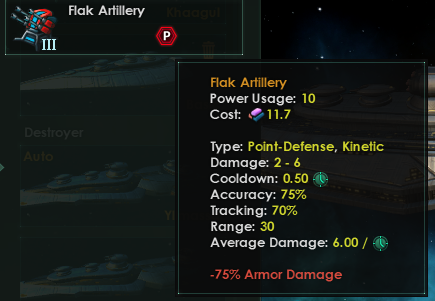
Point-Defense (PD) modules are tiny flak guns or lasers specifically designed to shoot down small fast-moving targets. Unlike other weapons, they can shoot down explosives coming your way, preventing them from doing damage. PD will prioritize firing at any explosive within its (small) range, inflicting damage according to the same rules as firing at a regular ship. If a fleet has enough PD, it can counter virtually all enemy explosives, rendering them effectively useless.
Note, however, that using PD means sacrificing regular weapon slots, meaning you won’t be doing as much damage to enemy ships as you would without the PD. PD has a maximum range of only 30. We’ll look into different ranges later in the Combat Computer section, but for now it suffices to say that only corvettes will want to stay at such short-range. So if you put PD on a corvette and it is withing 30 range of a ship, the PD will also shoot at the enemy ship, dealing decent damage. If you put PD on a destroyer that’ll stay at range 50, however, the PD will only help if the enemy decides to come to you, like with a flock of corvettes.
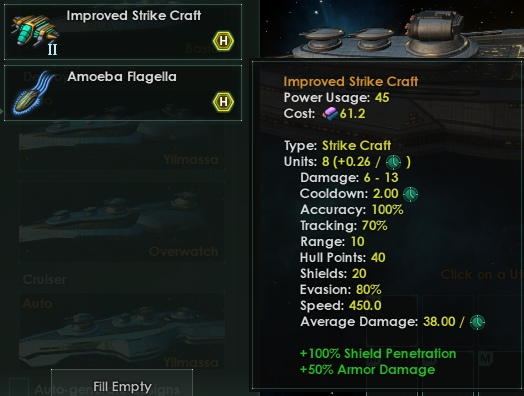
Finally there’s Hangars providing Strike Craft. Strike craft are small spacecraft launched from the bigger ships. Think TIE-Fighters from Star Wars. Strike craft function very similarly to explosive weapons in that they exist as separate entities with stats who can be targeted by PD. Strike craft don’t just fly into the enemy ship and go BOOM, however. They stick around, acting as additional ships providing continuous fire. A hangar launches a set number of strike craft (in this case 8) and every now and then (about every 4 days for this type, with 0.26 progress per day) it will launch one more. This means that, if the enemy cannot shoot down strike craft, they increase in number more and more, slowly overwhelming their enemy with rapid fire.
Like explosives, they are hard-countered by PD. Although strike-craft have the potential to inflict more damage than explosives, they do so over a longer period of time, while explosives inflict a lot of damage instantly if they get through. So if your enemy has a strong PD array, your strike craft will be shot down before they can fire that much.
Related Posts:
- Stellaris Lithoid Necrophage with Aquatics Guide
- Stellaris Fix Long Loading Times, Mod Conflicts, Cursor Lock, UX/UI and Gamepad
- Stellaris How to Steal Relics from Other Empires
